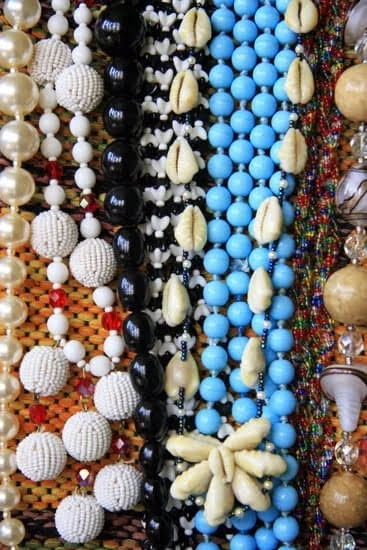Are you interested in learning how to make handmade resin jewelry? This unique and beautiful craft has been gaining popularity for its versatility and creativity. In this article, we will explore the art of creating stunning resin jewelry from scratch. From the history of resin jewelry making to the various techniques and materials needed, we will guide you through the process of crafting your very own pieces.
Handmade resin jewelry is not only visually appealing, but it also allows for endless customization and personalization. The use of resin as a medium offers an opportunity to create truly one-of-a-kind pieces that reflect your individual style and creativity. Whether you’re a beginner or experienced crafter, making resin jewelry can be a fulfilling and rewarding endeavor.
Resin jewelry making has a rich history dating back to ancient times when natural resins were used to create decorative ornaments. Today, modern artisans have embraced the art form and continue to push the boundaries of traditional techniques. Join us as we delve into the world of handmade resin jewelry, exploring its origins and timeless allure.
Materials Needed for Handmade Resin Jewelry
When it comes to making handmade resin jewelry, having the right materials is crucial to the success of your project. Here is a list of essential materials needed to start making resin jewelry:
- Epoxy Resin: This is the primary material used for creating resin jewelry. Epoxy resin comes in two parts – resin and hardener – that need to be mixed together in the correct proportions.
- Molds: You will need molds to pour the resin into in order to create different shapes and designs for your jewelry pieces. Silicone molds are popular for this purpose as they are flexible and easy to remove the cured resin from.
- Colorants: To add color and visual interest to your resin jewelry, you will need pigments or dyes specifically designed for use with epoxy resin.
- Mixing tools: It’s important to have plastic cups, wooden sticks, and mixing bowls dedicated solely for working with resin. Avoid using items that may contain moisture or contaminants that could affect the curing process.
- Protective Gear: Working with resin requires good ventilation and protective gear such as gloves, a mask, and safety goggles.
Where to purchase these materials:
These materials can be purchased from various craft stores, online retailers specializing in jewelry making supplies, or directly from manufacturers. It’s important to ensure that you are buying high-quality materials that are safe for use with skin contact.
By gathering these essential materials, you’ll be well-prepared to embark on your journey of creating beautiful handmade resin jewelry. Let’s move on to selecting the right type of resin for your specific projects.
Choosing the Right Resin for Your Jewelry
When it comes to making handmade resin jewelry, choosing the right type of resin is crucial to the success of your project. There are several different types of resin available, each with its own unique properties and uses. Understanding the differences between them will help you select the best resin for your specific jewelry-making needs.
Firstly, it’s important to know that there are two main types of resin: epoxy resin and polyester resin. Epoxy resin is known for its clarity and durability, making it a popular choice for jewelry making. On the other hand, polyester resin is more affordable but may not be as clear as epoxy resin. Consider the specific qualities you want in your finished piece when deciding which type of resin to use.
Once you’ve chosen the type of resin, you’ll also need to consider other factors such as viscosity and curing time. Some resins have a thicker consistency, while others are more fluid. The curing time can range from just a few hours to a full day or longer. Consider the intricacy of your design and how much time you have to work on your project when selecting a resin with the right viscosity and curing time.
To ensure that you choose the best resin for your handmade jewelry project, here is a helpful list:
- Epoxy Resin (such as ArtResin or Pro Marine Supplies)
- Polyester Resin (such as Environmental Technology or Smooth-On)
- Transparent Dyes or Pigments
- Measuring Cups and Stir Sticks
- Gloves and Safety Mask
You can purchase these materials at specialty craft stores, online retailers, or directly from manufacturers’ websites. Take into account the specific requirements for your project when selecting both your primary materials and any additional embellishments you may want to include in your designs.
By choosing the right type of resin for your handmade jewelry projects, along with careful consideration of other necessary materials like dyes and tools, you can create stunning pieces that reflect your own unique style and creativity.
Preparing and Mixing Resin
Before diving into the world of handmade resin jewelry, it is essential to understand the process of preparing and mixing resin. Resin is a versatile material that, when properly handled, can result in stunning and durable jewelry pieces. The first step in creating resin jewelry is to gather the necessary materials, including resin, catalyst or hardener, mixing cups, stirring sticks, and any desired colorants or decorative elements.
To begin the mixing process, it is crucial to carefully read and follow the manufacturer’s instructions for the specific type of resin being used. In general, resin is mixed with a hardener or catalyst in a precise ratio to ensure proper curing and durability. This step may require careful measurements using graduated mixing cups to achieve an accurate mixture.
When working with resin, it is important to prioritize safety by wearing protective gloves and working in a well-ventilated area. Some resins may emit fumes during the mixing process, so proper ventilation and possibly a respirator may be necessary. Additionally, be mindful of the potential for skin irritation from prolonged contact with uncured resin.
Once the resin and hardener are measured out according to the manufacturer’s instructions, they should be combined in a clean mixing cup using a stir stick. It is important to mix the components thoroughly but gently to avoid introducing air bubbles into the mixture. Properly mixed resin will appear clear and free of streaks or cloudiness.
Understanding how to prepare and mix resin for jewelry making ensures that your finished pieces will be strong, beautiful, and long-lasting. By following these steps and prioritizing safety throughout the process, you will be well on your way to creating stunning handmade resin jewelry that showcases your unique style and creativity.
Adding Color and Decorations to Resin Jewelry
Various Techniques for Adding Color and Decorative Elements
There are several ways to add color and special decorative elements to resin jewelry. One popular method is by using resin dyes or pigments, which are specifically designed for use with resin. These come in a wide range of colors and can be combined to create custom shades.
Another option is to incorporate items such as glitter, sequins, dried flowers, or small beads into the resin mixture before pouring it into the mold. This allows for endless possibilities in creating unique and personalized designs.
Tips for Achieving Unique and Beautiful Designs
When adding color and decorations to resin jewelry, it’s important to keep in mind that less is often more. Overdoing it with too many colors or decorative elements can result in a cluttered and unappealing final product. Instead, focus on creating a cohesive color palette and carefully select decorative elements that complement each other. Additionally, consider using techniques such as layering or creating swirl patterns with different colors to achieve beautiful, artistic effects.
Experimenting With Different Techniques
The beauty of handmade resin jewelry lies in its versatility, allowing for endless creative possibilities. With the right materials and techniques, you can experiment with various methods of adding color and decorations to your resin jewelry. Whether it’s creating marbled effects, incorporating metallic leafs, or embedding small charms or trinkets within the resin, there are countless ways to make each piece of jewelry truly one-of-a-kind.
By experimenting with different techniques and combinations of colors and decorations, you can create stunning handmade resin jewelry that reflects your personal style and creativity. Remember that practice makes perfect, so don’t be afraid to try new ideas and see what works best for your designs.
Creating Molds for Resin Jewelry
Making your own molds for resin jewelry is a great way to add a personal touch to your creations. There are several different methods you can use to create molds, depending on the shape and size of the jewelry pieces you want to make. One popular option is using silicone mold putty, which allows you to easily make custom molds that can be used over and over again.
To make a silicone mold for resin jewelry, start by kneading equal parts of the two-component putty together until they are fully blended. Then, press the putty around the object you want to create a mold of, making sure to cover it completely and capture all the details. Once the putty has set, carefully remove the original object and you will be left with a flexible silicone mold that can be used with resin.
If you prefer not to make your own molds, there are also pre-made silicone molds available for purchase. These come in a wide variety of shapes and sizes, including popular designs like flowers, geometric shapes, and animals. Pre-made molds offer convenience and consistency in your resin jewelry making process.
When creating molds for resin jewelry, it’s important to consider the type of resin you’ll be using and any specific design elements in your jewelry pieces. This will help ensure that your molds are well-suited for your projects and that you achieve the desired results in your handmade resin jewelry.
| Resin Mold Making Method | Benefits |
|---|---|
| Silicone Mold Putty | Easily customizable and reusable |
| Pre-Made Silicone Molds | Convenient and consistent designs |
Tips for Curing and Finishing Resin Jewelry
Proper Curing Techniques
After you have poured and mixed the resin into your jewelry molds, it is crucial to allow the resin to cure properly. This process ensures that the resin hardens and becomes durable for wear.
The curing time will depend on the type of resin you are using, but generally, it can take anywhere from 24 to 72 hours. It is essential to follow the manufacturer’s instructions for curing times and conditions, such as temperature and humidity levels, to achieve the best results.
Adding Findings and Finishing Touches
Once your resin jewelry pieces are fully cured, it’s time to add findings such as jump rings, earring hooks, or necklace chains to complete your designs. You can also sand or polish the edges of your resin pieces for a professional finish.
Additionally, you may choose to add decorative elements such as glitter or metallic flakes at this stage for extra flair. Take your time with these finishing touches as they can greatly enhance the overall look of your handmade resin jewelry.
Ensuring Longevity of Resin Jewelry
To ensure that your handmade resin jewelry lasts a long time, it’s important to store them properly when not in use. Avoid exposing them to direct sunlight for extended periods as this can cause the colors to fade over time. Also, be mindful of exposing your resin jewelry to harsh chemicals or excessive moisture, as this can damage the resin over time. By taking proper care of your finished pieces, you can enjoy wearing them for years to come.
Making handmade resin jewelry is a creative and rewarding craft that allows for endless possibilities in design and style. From choosing the right resin to adding unique decorations and finally finishing off with proper curing techniques, each step contributes to creating beautiful and one-of-a-kind pieces. With these tips in mind, you’re well on your way to mastering the art of making stunning handmade resin jewelry.
Troubleshooting and Common Mistakes
Making handmade resin jewelry can be a rewarding and creative hobby, but like any craft, it comes with its own set of challenges. In this section, we will discuss some common issues that may arise when making resin jewelry and provide tips and solutions for troubleshooting and fixing mistakes in the resin jewelry making process.
One common problem when working with resin is bubbles forming in the finished piece. To prevent this, it’s important to mix the resin slowly and thoroughly, as well as using a heat gun or torch to remove any remaining bubbles on the surface. If bubbles still form, you can try popping them with a pin or adding a top coat of resin to smooth out the surface.
Another issue that may occur is the resin not curing properly. This could be due to inaccurate measurements when mixing the resin, low temperatures in your workspace, or expired or old resin. To troubleshoot this problem, double-check your measurements and consider using a thermometer to ensure the correct temperature for curing. Additionally, make sure to use fresh resin within its shelf life for best results.
Lastly, accidental spills or drips on your work surface can be frustrating when working with resin. To avoid this, always work on a protected surface such as a silicone mat or wax paper. If spills do occur, quickly clean them up with rubbing alcohol before the resin cures completely.
By being aware of these common issues and knowing how to address them, you can develop your skills in making handmade resin jewelry and create beautiful pieces without feeling discouraged by small setbacks in the process. With practice and patience, you’ll be able to troubleshoot these challenges and improve your technique over time.
Conclusion
In conclusion, learning how to make handmade resin jewelry can be a rewarding and fulfilling craft to explore. The appeal and uniqueness of handmade resin jewelry lies in its endless creative possibilities and the ability to create one-of-a-kind pieces. With a brief history of resin jewelry making in mind, enthusiasts can appreciate the evolution of this art form and find inspiration for their own creations.
By understanding the materials needed, choosing the right type of resin, and learning how to properly prepare and mix it, aspiring resin jewelry makers can embark on their creative journey with confidence. The addition of color, decorations, and unique designs further enhances the beauty and personal touch of each piece. Creating molds for resin jewelry not only allows for customization but also opens up opportunities for experimentation.
As beginners learn proper methods for curing resin jewelry, adding finishing touches, and troubleshooting common mistakes, they will gain valuable skills that will improve their craft. By following the tips provided in this guide, readers can confidently start creating their own unique handmade resin jewelry pieces. Ultimately, exploring this art form offers individuals an opportunity to express their creativity and create stunning wearable art.
Frequently Asked Questions
How Do You Make Resin Jewelry at Home?
Making resin jewelry at home requires several steps. First, you need to gather all the necessary supplies such as resin, measuring cups, mixing sticks and molds. Then, carefully measure and mix the resin according to the instructions.
Once mixed, you can add in any desired colors or materials before pouring it into the molds. After allowing it to cure, you can then remove the pieces from the molds and finish them as desired.
What Supplies Do I Need to Make Resin Jewelry?
When making resin jewelry, you will need basic supplies like resin (both epoxy and UV resin), measuring cups or beakers for accurate mixing, stirring sticks or a mixing tool, silicone molds in various shapes/sizes, protective gear like gloves and a mask for safety when working with resin, as well as any additional materials for decoration such as glitter or dried flowers.
What Type of Resin Do You Use to Make Jewelry?
The type of resin used to make jewelry typically depends on personal preference and project needs. Epoxy resin is a popular choice for its durability and versatility. It is also known for its strong adhesive properties.
On the other hand, UV resin cures quickly when exposed to ultraviolet light, making it convenient for quick projects. Both types of resin have their own benefits and drawbacks so it’s important to consider these factors when choosing which one to use in your jewelry making endeavors.

Welcome to my jewelry blog! My name is Sarah and I am the owner of this blog.
I love making jewelry and sharing my creations with others.
So whether you’re someone who loves wearing jewelry yourself or simply enjoys learning about it, be sure to check out my blog for insightful posts on everything related to this exciting topic!





